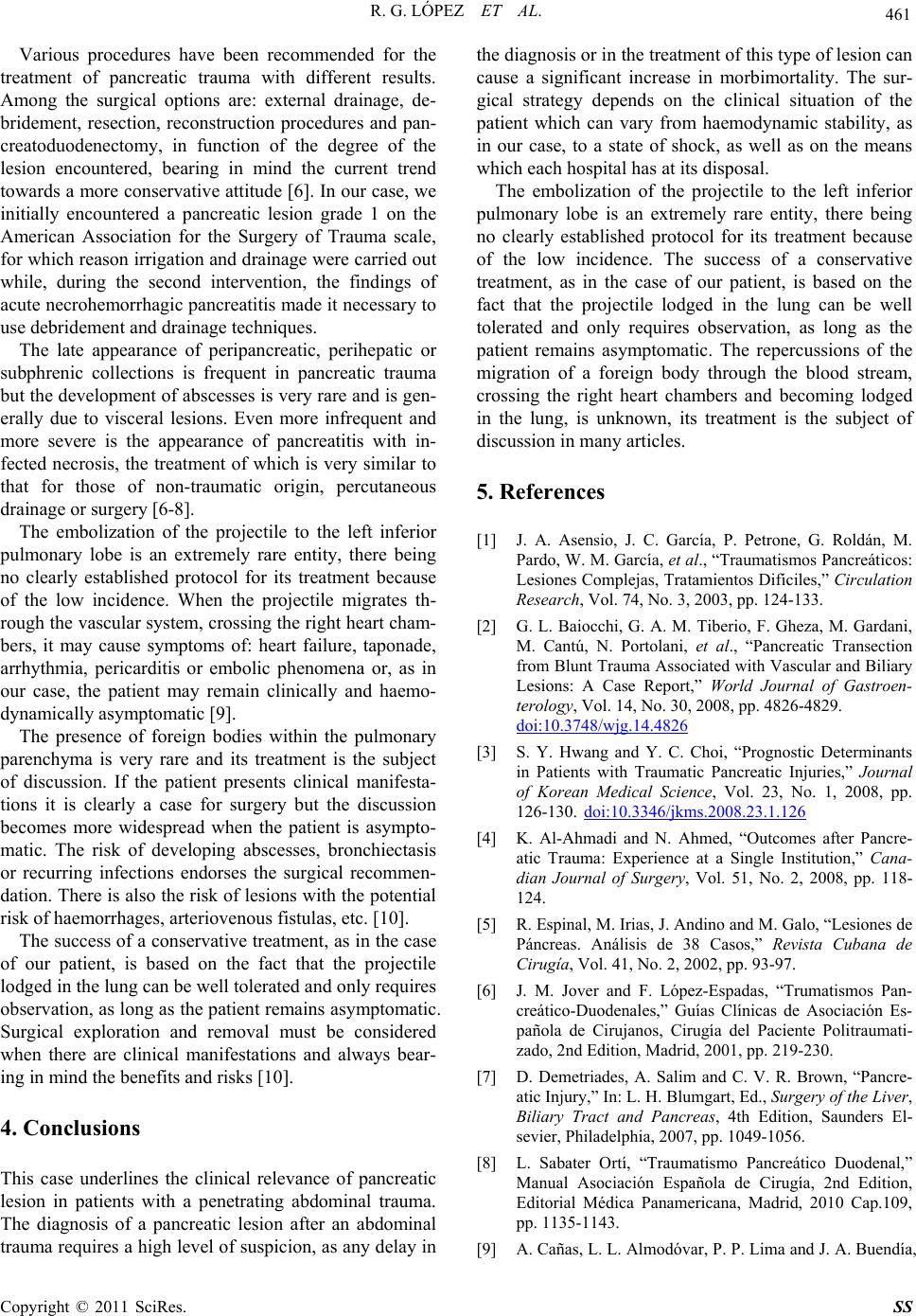
R. G. LÓPEZ ET AL.
461
Various procedures have been recommended for the
treatment of pancreatic trauma with different results.
Among the surgical options are: external drainage, de-
bridement, resection, reconstruction procedures and pan-
creatoduodenectomy, in function of the degree of the
lesion encountered, bearing in mind the current trend
towards a more conservative attitude [6 ]. In our case, we
initially encountered a pancreatic lesion grade 1 on the
American Association for the Surgery of Trauma scale,
for which reason irrigation and drainage were carried out
while, during the second intervention, the findings of
acute necrohemorrhagic pancreatitis made it necessary to
use debridement and drainage techni qu es .
The late appearance of peripancreatic, perihepatic or
subphrenic collections is frequent in pancreatic trauma
but the development of abscesses is very rare and is gen-
erally due to visceral lesions. Even more infrequent and
more severe is the appearance of pancreatitis with in-
fected necrosis, the treatment of which is very similar to
that for those of non-traumatic origin, percutaneous
drainage or surgery [6-8].
The embolization of the projectile to the left inferior
pulmonary lobe is an extremely rare entity, there being
no clearly established protocol for its treatment because
of the low incidence. When the projectile migrates th-
rough the vascular system, crossing the right heart cham-
bers, it may cause symptoms of: heart failure, taponade,
arrhythmia, pericarditis or embolic phenomena or, as in
our case, the patient may remain clinically and haemo-
dynamically asymptomatic [9].
The presence of foreign bodies within the pulmonary
parenchyma is very rare and its treatment is the subject
of discussion. If the patient presents clinical manifesta-
tions it is clearly a case for surgery but the discussion
becomes more widespread when the patient is asympto-
matic. The risk of developing abscesses, bronchiectasis
or recurring infections endorses the surgical recommen-
dation. There is also the risk of lesions with the poten tial
risk of haemorrhages, arteriovenous fistulas, etc. [10].
The success of a conservative treatment, as in the case
of our patient, is based on the fact that the projectile
lodged in the lung can be well tolerated and only requires
observation, as long as the patient remains asymptomatic.
Surgical exploration and removal must be considered
when there are clinical manifestations and always bear-
ing in mind the benefits and risks [10].
4. Conclusions
This case underlines the clinical relevance of pancreatic
lesion in patients with a penetrating abdominal trauma.
The diagnosis of a pancreatic lesion after an abdominal
trauma requires a high level of suspicion, as any delay in
the diagnosis or in the treatment of this type of lesion can
cause a significant increase in morbimortality. The sur-
gical strategy depends on the clinical situation of the
patient which can vary from haemodynamic stability, as
in our case, to a state of shock, as well as on the means
which each hospital has at its disposal.
The embolization of the projectile to the left inferior
pulmonary lobe is an extremely rare entity, there being
no clearly established protocol for its treatment because
of the low incidence. The success of a conservative
treatment, as in the case of our patient, is based on the
fact that the projectile lodged in the lung can be well
tolerated and only requires observation, as long as the
patient remains asymptomatic. The repercussions of the
migration of a foreign body through the blood stream,
crossing the right heart chambers and becoming lodged
in the lung, is unknown, its treatment is the subject of
discussion in many articles.
5. References
[1] J. A. Asensio, J. C. García, P. Petrone, G. Roldán, M.
Pardo, W. M. García, et al., “Traumatismos Pancreáticos:
Lesiones Complejas, Tratamientos Difíciles,” Circulation
Research, Vol. 74, No. 3, 2003, pp. 124-133.
[2] G. L. Baiocchi, G. A. M. Tiberio, F. Gheza, M. Gardani,
M. Cantú, N. Portolani, et al., “Pancreatic Transection
from Blunt Trauma Associated with Vascular and Biliary
Lesions: A Case Report,” World Journal of Gastroen-
terology, Vol. 14, No. 30, 2008, pp. 4826-4829.
doi:10.3748/wjg.14.4826
[3] S. Y. Hwang and Y. C. Choi, “Prognostic Determinants
in Patients with Traumatic Pancreatic Injuries,” Journal
of Korean Medical Science, Vol. 23, No. 1, 2008, pp.
126-130. doi:10.3346/jkms.2008.23.1.126
[4] K. Al-Ahmadi and N. Ahmed, “Outcomes after Pancre-
atic Trauma: Experience at a Single Institution,” Cana-
dian Journal of Surgery, Vol. 51, No. 2, 2008, pp. 118-
124.
[5] R. Espinal, M. Irias, J. A ndino and M. Galo, “Lesiones de
Páncreas. Análisis de 38 Casos,” Revista Cubana de
Cirugía, Vol. 41, No. 2, 2002, pp. 93-97.
[6] J. M. Jover and F. López-Espadas, “Trumatismos Pan-
creático-Duodenales,” Guías Clínicas de Asociación Es-
pañola de Cirujanos, Cirugía del Paciente Politraumati-
zado, 2nd Edition, Madrid, 2001, pp. 219-230.
[7] D. Demetriades, A. Salim and C. V. R. Brown, “Pancre-
atic Injury,” In: L. H. Blumgart, Ed., Surgery of the Liver,
Biliary Tract and Pancreas, 4th Edition, Saunders El-
sevier, Philadelphia, 2007, pp. 1049-1056.
[8] L. Sabater Ortí, “Traumatismo Pancreático Duodenal,”
Manual Asociación Española de Cirugía, 2nd Edition,
Editorial Médica Panamericana, Madrid, 2010 Cap.109,
pp. 1135-1143.
[9] A. Cañas, L. L. Almodóvar, P. P. Lima and J. A. Buendía,
Copyright © 2011 SciRes. SS